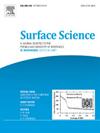Effect of tensile strain on photoelectric properties of C-doped SnSe2 system
IF 2.1
4区 化学
Q3 CHEMISTRY, PHYSICAL
引用次数: 0
Abstract
The geometric structure, stability, electronic structure and optical properties of the pristine SnSe2 and C-doped SnSe2 systems under tensile strain were computed using first principles. The findings indicate that the Sn-Se bond of the C-doped SnSe2 system is longer than that of the pristine SnSe2 system under the same tensile strain, and all systems in the low strain range can be stably formed. The electronic structure indicates that pristine SnSe2 is an indirect bandgap semiconductor. Under the action of tensile strain, the introduction of C atoms leads to a transformation of the band gap type. The valence band of the C-doped SnSe2 system is mainly attributed to the Se-4p and Sn-5p orbitals, while the conduction band is primarily assigned by Se-4p, Sn-5s and C-2p orbitals.The optical properties show that the peaks of ε1(ω) and ε2(ω) of both the pristine and doped systems are red-shifted under tensile strain, and the dielectric function ε2(ω), absorption and reflection peaks of the doped system are lower than those of the pristine system, indicating that the introduction of C atoms can effectively improve the conductivity of the materials. Meanwhile, the absorption peak of the doped system was blue-shifted to the high-energy region relative to that of the pristine system. Under the action of tensile strain, the reflection peak of the pristine SnSe2 system is redshifted, indicating that the tensile strain improves the utilization rate of the SnSe2 system for ultraviolet light and can be used as an excellent alternative material for ultraviolet light detectors.

拉伸应变对掺杂c - SnSe2体系光电性能的影响
利用第一性原理计算了原始SnSe2和掺杂c的SnSe2体系在拉伸应变下的几何结构、稳定性、电子结构和光学性质。结果表明,在相同的拉伸应变下,掺杂c的SnSe2体系的Sn-Se键比未掺杂的SnSe2体系的Sn-Se键长,并且在低应变范围内均能稳定形成体系。电子结构表明原始SnSe2是一种间接带隙半导体。在拉伸应变的作用下,C原子的引入导致带隙类型的转变。掺杂c的SnSe2体系的价带主要归属于Se-4p和Sn-5p轨道,导带主要归属于Se-4p、Sn-5s和C-2p轨道。光学性质表明,在拉伸应变作用下,原始体系和掺杂体系的ε1(ω)和ε2(ω)峰均发生红移,掺杂体系的介电函数ε2(ω)、吸收峰和反射峰均低于原始体系,表明C原子的引入可以有效提高材料的导电性。同时,掺杂体系的吸收峰相对于原始体系的吸收峰蓝移到高能区。在拉伸应变的作用下,原始SnSe2体系的反射峰发生了红移,表明拉伸应变提高了SnSe2体系对紫外光的利用率,可以作为紫外光探测器的优良替代材料。
本文章由计算机程序翻译,如有差异,请以英文原文为准。
求助全文
约1分钟内获得全文
求助全文
来源期刊

Surface Science
化学-物理:凝聚态物理
CiteScore
3.30
自引率
5.30%
发文量
137
审稿时长
25 days
期刊介绍:
Surface Science is devoted to elucidating the fundamental aspects of chemistry and physics occurring at a wide range of surfaces and interfaces and to disseminating this knowledge fast. The journal welcomes a broad spectrum of topics, including but not limited to:
• model systems (e.g. in Ultra High Vacuum) under well-controlled reactive conditions
• nanoscale science and engineering, including manipulation of matter at the atomic/molecular scale and assembly phenomena
• reactivity of surfaces as related to various applied areas including heterogeneous catalysis, chemistry at electrified interfaces, and semiconductors functionalization
• phenomena at interfaces relevant to energy storage and conversion, and fuels production and utilization
• surface reactivity for environmental protection and pollution remediation
• interactions at surfaces of soft matter, including polymers and biomaterials.
Both experimental and theoretical work, including modeling, is within the scope of the journal. Work published in Surface Science reaches a wide readership, from chemistry and physics to biology and materials science and engineering, providing an excellent forum for cross-fertilization of ideas and broad dissemination of scientific discoveries.
 求助内容:
求助内容: 应助结果提醒方式:
应助结果提醒方式:


